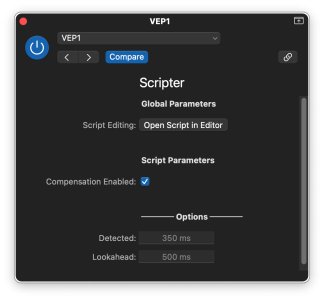First of all ArtAlign doesn't change the lookahead behavior of VePro. It simply adds a different amount of latency to each note depending on how you have the JSON configured.
Right, it compensates for whatever Latency Fixer values are being fed.
Why are you enabling and disabling it?
I'm using it as part of a whole modal template setup where I have 1 of 2 states true — a low-latency tracking mode and a high-latency mixing mode. It shouldn't be active while I'm tracking, but it should be active while I'm mixing.
Why would latency fixer be receiving the same automation to enable disable? that doesn't make sense.
It's not—it's receiving a separate control (CC33), but when Scripter plug-ins toggle (as part of a Smart Control/Summing Stack setup) they block simultaneous CC messages on disable.
again, I don't really understand exactly what you're trying to do. The only reason for that checkbox is not to enable it and disable it dynamically while playing. its so that you can turn it if when you want to play in a part with your midi controller, because otherwise a lot of delay will be added. its easier to play in the part with the delay minimized.
Right, it's a modality, not something to be tweaked live.
It doesn't sound you are using the script properly. please read the wiki docs careful to understand it.
I have, but it (+ a delay compensation plug-in) does not behave properly if used in the way specified in the wiki. That combo *does* behave properly when the delay compensation plug-in is hosted within VEP instead of in Logic. It works fine when drawing in automation to achieve the two toggles (that is: Latency Fixer on/off; ArtAlign active/inactive).
However, I don't want to draw in automation to automate this (as this shouldn't be a dynamic automation, nor should it be tied to anything in the playback/rendering, but should simply be a modal state), so the only way to accomplish such a change without drawing in automation is to have a toggle button that sends a control (or multiple controls) at the same time.
But without drawn in automation, the only way to control both things simultaneously is to send it simultaneously...which is impossible when disabling Scripter blocks MIDI thru at that moment.
I will not have any time to work on these scripts any time soon, but if you would like to contribute some ideas please post an issue request through the gitlab website.
you are of course welcome to take the script and tweak it to your heart's content if you want to dynamically enable/disable its behavior during playback but I'm not sure why you would want to do that.
Thankfully, that is not what I am trying to do.





